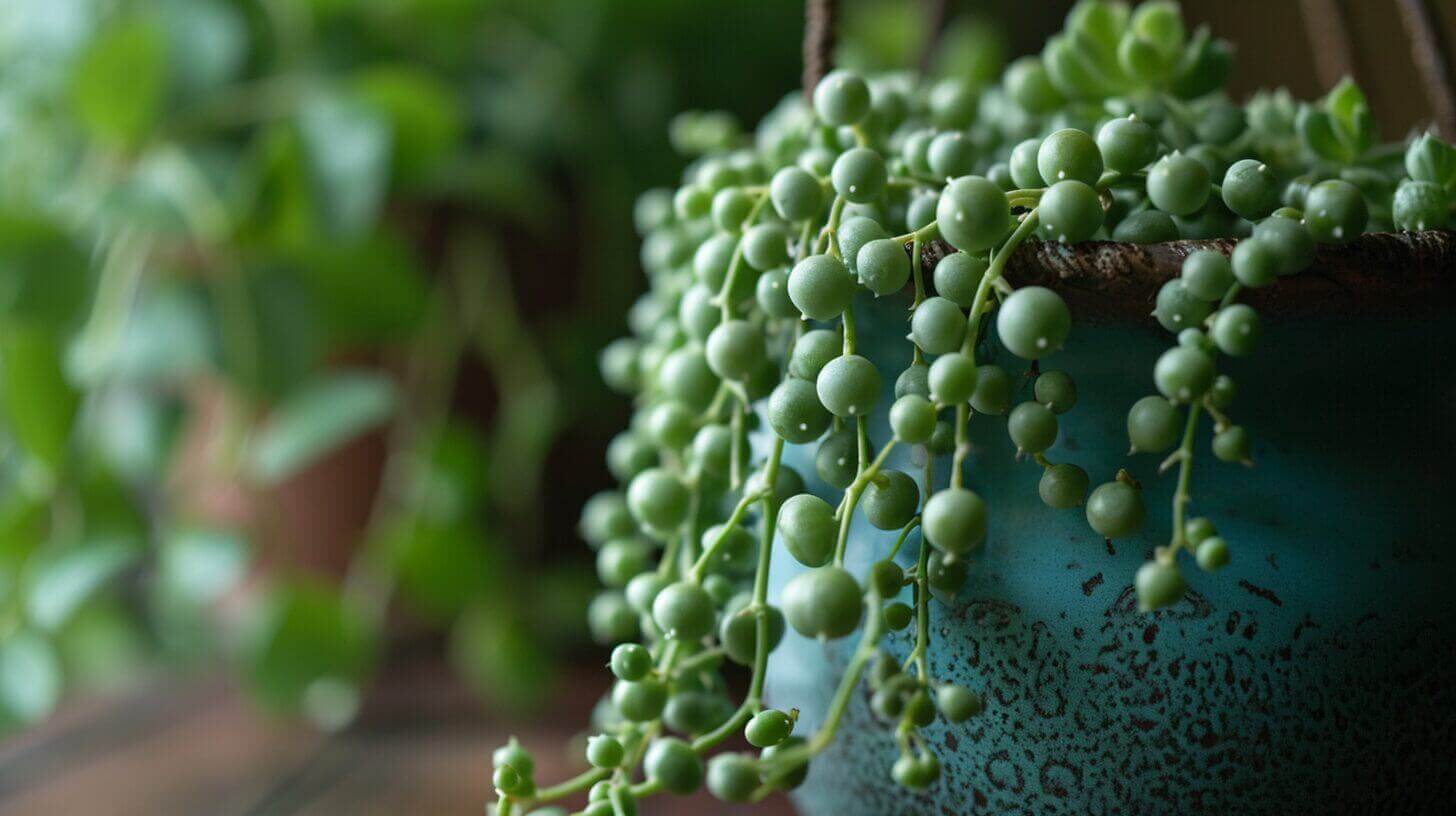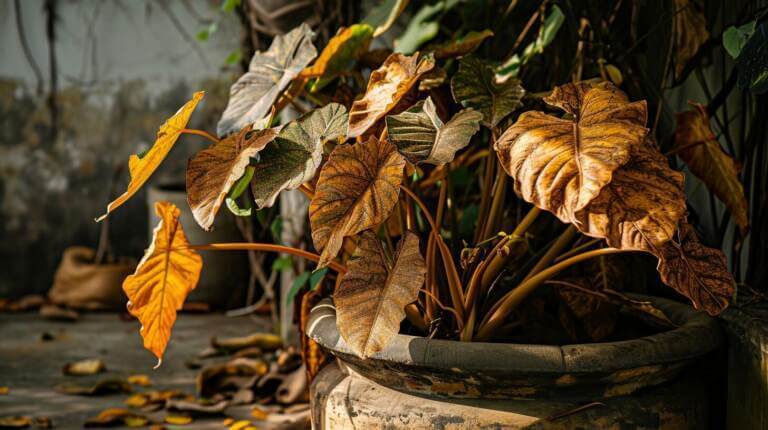How Fast Does String of Pearls Grow? Growth Rate and Maximum Size
The string of pearls plant, also known as string of beads or necklace plant(senecio rowleyanus), is a fast-growing succulent. It gets its name from the appearance of its leaves, which resemble pearl-sized peas strung along delicate stems. The plant can grow up to 3 feet long at maturity. It has a trailing growth habit, making it ideal for hanging baskets and macrame hangers. The plant blooms with tiny white flowers in the summer and goes dormant in the fall and winter. String of pearls prefers bright, indirect light and well-draining soil, formulated for cacti or succulents. Water sparingly, allowing the soil to dry out between waterings. Fertilize monthly during the growing season and reduce to every three months during dormancy.
Key Takeaways:
- The string of pearls plant is a fast-growing succulent with a trailing growth habit.
- It can grow up to 3 feet long at maturity.
- String of pearls prefers bright, indirect light and well-draining soil formulated for cacti or succulents.
- Water sparingly, allowing the soil to dry out between waterings.
- Fertilize monthly during the growing season and reduce to every three months during dormancy.
Growing Conditions for String of Pearls
The string of pearls plant, also known as the string of beads or necklace plant, is a popular succulent that requires specific growing conditions for optimal health and growth. Here are the key factors to consider:
- Well-draining soil: String of pearls prefers a sandy, well-draining soil mix formulated for cacti or succulents. This helps prevent waterlogged roots and reduces the risk of root rot.
- Bright indirect light: Place your string of pearls in a location that receives bright, indirect light. A north-facing or east-facing window is ideal. Avoid exposing the plant to intense, direct sunlight, as it can lead to sunburn.
- Watering schedule: Allow the soil to dry out between waterings, especially during the plant’s dormant period in the fall and winter. Overwatering can cause root rot, so it’s important to water sparingly.
- Fertilization: Fertilize the string of pearls plant monthly during the growing season with a diluted houseplant fertilizer. Reduce fertilization to every three months during the plant’s dormant phase.
Table: Ideal Growing Conditions for String of Pearls
| Growing Condition | Requirement |
|---|---|
| Soil | Well-draining, sandy soil mix formulated for cacti or succulents |
| Light | Bright indirect light, avoid direct sunlight |
| Watering | Sparingly, allowing soil to dry out between waterings |
| Fertilization | Monthly during the growing season, diluted houseplant fertilizer |
Common Growing Problems and Solutions for String of Pearls
While the string of pearls plant is typically easy to care for, it can face some common growing problems. Understanding these issues and their solutions can help you keep your string of pearls healthy and thriving.
Drought Stress and Overwatering
One of the common problems with string of pearls is finding the right balance when it comes to watering. This plant is prone to both drought stress and overwatering. Overwatering can lead to root rot, so it’s important to allow the soil to dry out slightly between waterings. On the other hand, underwatering can cause the plant’s leaves to shrivel and drop. To avoid these problems, water your string of pearls sparingly, only when the top inch of the soil feels dry.
Sunburn and Light Exposure
String of pearls plants prefer bright, indirect light. However, exposing them to too much direct sunlight can cause sunburn. Signs of sunburn include brown or yellow patches on the leaves. To prevent this issue, place your string of pearls in a location that receives bright, indirect light, such as a north-facing or east-facing window. If you notice signs of sunburn, move the plant to a slightly shadier spot.
Pests and Pruning
Like many houseplants, string of pearls can be susceptible to pests such as mealybugs and aphids. If you notice any signs of infestation, such as tiny white bugs or sticky residue on the leaves, treat the plant with insecticidal soap or neem oil. Regular pruning is also important for maintaining the health of your plant. Prune any dead or damaged stems to promote fuller growth and remove any potential hiding spots for pests.
| Common Problems | Solutions |
|---|---|
| Drought stress | Water sparingly, allowing the soil to dry out slightly between waterings. |
| Overwatering | Avoid overwatering to prevent root rot. |
| Sunburn | Place the plant in a location with bright, indirect light to prevent sunburn. |
| Pests | Treat infestations with insecticidal soap or neem oil. |
| Pruning | Regularly prune dead or damaged stems for healthier growth. |
Propagating String of Pearls
If you’re looking to expand your collection of string of pearls plants or share this beautiful succulent with friends, propagating through stem cuttings is a simple and effective method. By following a few steps, you can create new plants from existing ones and enjoy the process of watching them grow.
To start propagating, select several 6-inch stems from a mature mother plant. Allow the cut ends to callus over for one to three days, which helps prevent rotting. Once the ends are calloused, remove the bottom leaves, ensuring that three to four leaf nodes remain on each stem. These nodes are where the new roots will grow from.
Next, prepare a well-draining succulent soil mix and plant the cuttings into it. Bury the stripped end of each stem, making sure that the leaf nodes are beneath the soil surface. Place the newly planted cuttings in a warm spot with bright, indirect light. Water sparingly, allowing the soil to dry out between waterings.
After four to six weeks, the cuttings should have rooted and can be cared for like any other string of pearls plant. It’s important to note that not every cutting will successfully root, so it’s a good idea to take several to increase your chances of success. With a little patience and care, you’ll have new string of pearls plants to enjoy or share with others.
Table: Steps for Propagating String of Pearls
| Step | Description |
|---|---|
| 1 | Select 6-inch stems from a mature mother plant. |
| 2 | Allow the cut ends to callus over for one to three days. |
| 3 | Remove the bottom leaves, leaving three to four leaf nodes on each stem. |
| 4 | Plant the cuttings in well-draining succulent soil, burying the stripped end of the stem. |
| 5 | Place the newly planted cuttings in a warm spot with bright, indirect light. |
| 6 | Water sparingly, allowing the soil to dry out between waterings. |
| 7 | After four to six weeks, the cuttings should root and can be cared for as usual. |
Repotting and Pot Size for String of Pearls
When it comes to the care of string of pearls plants, repotting plays an important role in ensuring their growth and vitality. As these plants mature, they may outgrow their current pots, necessitating the need for repotting. Repotting should be done at the beginning of the spring growing season, providing the plant with fresh soil and a larger pot to accommodate its growing roots.
Choosing the right pot size is crucial for the health of your string of pearls plant. It is recommended to select a pot that is only slightly larger than the current one, as a pot that is too large can hold excess moisture and lead to root rot. Additionally, using a pot with ample drainage holes is essential to prevent water from pooling at the bottom. Terra cotta pots are an excellent choice as they provide good airflow for the roots and help wick away excess moisture.
Table: Comparison of Pot Sizes for String of Pearls
| Pot Size | Plant Size | Root Health | Moisture Control |
|---|---|---|---|
| 4-inch pot | Young plant or small size | Healthy and compact | Requires frequent monitoring |
| 6-inch pot | Moderate growth | Well-established | Good moisture control |
| 8-inch pot | Larger and more mature plant | Extensive root system | Adequate moisture control |
To repot your string of pearls, gently remove the plant from its current pot, being careful not to damage the delicate stems and roots. Place a layer of fresh well-draining succulent or cactus soil mix at the bottom of the new pot. Then, carefully position the plant in the center of the pot, ensuring that the soil level remains the same as before. Backfill the remaining space with the soil mix, lightly pressing it down to secure the plant. Water sparingly after repotting and resume the usual watering schedule once the plant has settled into its new pot.
By providing the right pot size and repotting your string of pearls when needed, you can ensure that the plant has the space it requires to grow and thrive. Remember to monitor its growth regularly to determine if repotting is necessary, and always use a well-draining soil mix and a pot with proper drainage to maintain the plant’s health.
Factors Affecting the Growth of String of Pearls
When it comes to the growth of string of pearls, several factors come into play. Understanding and addressing these factors will help ensure the successful growth of these stunning plants.
Season: String of pearls experiences its main growth during the spring and summer seasons. During this time, provide adequate care and attention to support healthy growth.
Watering Schedule: Proper watering is crucial for optimal growth. It’s important to allow the soil to dry out between waterings, especially during the plant’s dormant period in the fall and winter.
Light, Temperature, and Humidity: String of pearls thrives in bright, indirect light. Ensure the plant is placed in a location that provides the right amount of light exposure. Additionally, maintaining appropriate temperature and humidity levels will positively impact its growth.
Pests, Soil Type, Pot Size, Fertilization, and Pruning: These factors can greatly influence the growth of string of pearls. Regularly inspect the plant for pests and treat them promptly. Use a well-draining soil mix formulated for succulents, and choose a pot that is slightly larger than the current one to allow room for growth. Fertilize the plant at the appropriate times and in the correct amounts. Pruning can help promote fuller and healthier growth.
FAQ
How fast does string of pearls grow? What is its growth rate and maximum size?
String of pearls is a fast-growing succulent that can grow up to 3 feet long at maturity.
What are the growing conditions for string of pearls?
String of pearls prefers well-draining soil, bright indirect light, and a watering schedule that allows the soil to dry out between waterings. It also benefits from monthly fertilization during the growing season.
What are common growing problems for string of pearls and how can they be solved?
Common growing problems for string of pearls include watering issues, sunburn, root rot, pests, and the need for pruning. These can be addressed by avoiding overwatering, providing adequate shade from direct sunlight, treating pests with insecticidal soap or neem oil, and pruning to promote fuller growth.
How can I propagate string of pearls?
String of pearls can be easily propagated through stem cuttings. Take several 6-inch stems from a mature plant, allow the cut ends to callus over, remove the bottom leaves, and plant the cuttings in well-draining succulent soil. Keep the cuttings in a warm place with bright, indirect light and water sparingly.
When and how should I repot string of pearls?
String of pearls should be repotted at the beginning of the spring growing season using a slightly larger pot with ample drainage holes. A well-draining succulent or cactus soil mix and terra cotta or clay pots are recommended.
What factors can affect the growth of string of pearls?
The growth of string of pearls can be influenced by factors such as season, watering schedule, light exposure, temperature and humidity levels, pests, soil type, pot size, fertilization, and pruning. Understanding and addressing these factors can help ensure successful growth.







